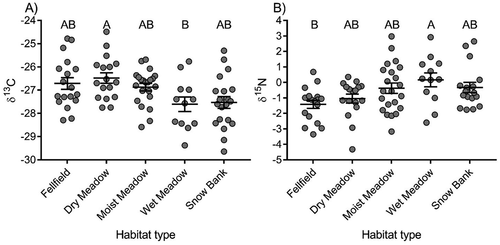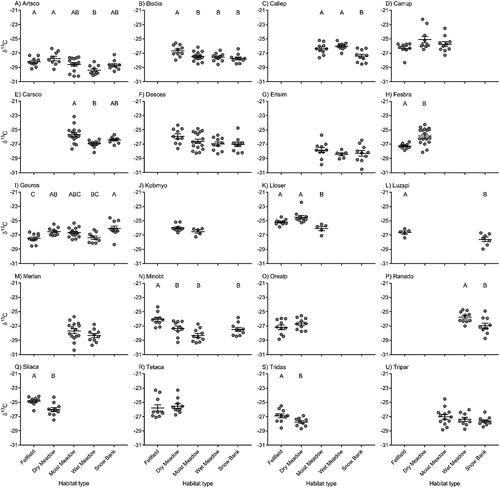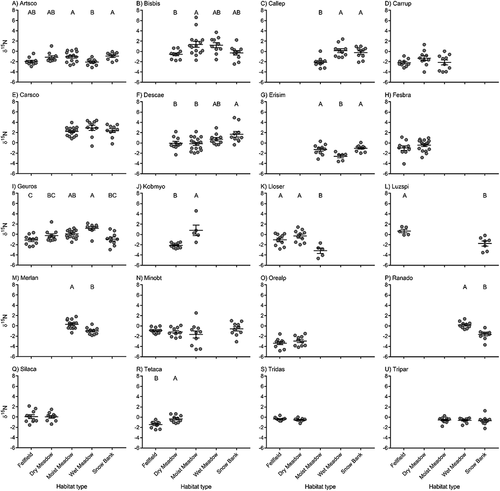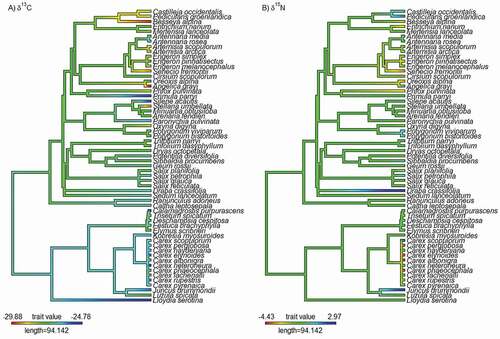Figures & data
Table 1. Across all alpine tundra habitat types and habitat specific values for Pagel’s λ
Figure 1. Variation in (a) δ13C and (b) δ15N among habitat types in alpine tundra. Each data point represents a species-level mean. The longer horizontal line represents the mean value for each habitat type and shorter horizontal lines represent the standard error of the mean. Letters represent significant differences among habitat types based on Tukey’s post hoc comparisons.

Figure 2. Intraspecific variation in δ13C among species sampled in multiple habitat types in alpine tundra. Habitats with no data points indicate that species was not present in that habitat type. The longer horizontal line represents the mean value for each habitat type and shorter horizontal lines represent one standard deviation. Letters represent significant differences among habitat types based on Tukey’s post hoc comparisons. Species codes: (a) Artemisia scopulorum (Artsco); (b) Bistorta bistortoides (Bisbis); (c) Caltha leptosepala (Callep); (d) Carex rupestris (Carrup); (e) Carex scopulorum (Carsco); (f) Deschampsia caespitosa (Desces); (g) Erigeron simplex (Erisim); (h) Festuca brachyphylla (Fesbra); (i) Geum rossii (Geuros); (j) Kobresia myosuroides (Kobmyo); (k) Lloydia serotina (Lloser); (l) Luzula spicata (Luzspi); (m) Mertensia lanceolate (Merlan); (n) Minuartia obtusiloba (Minobt); (o) Oreoxis alpina (Orealp); (p) Ranunculus adoneus (Ranado); (q) Silene acaulis (Silaca); (r) Tetraneuris acaulis (Tetaca); (s) Trifolium dasyphyllum (Tridas); (t) Trifolium parryi (Tripar).

Figure 3. Intraspecific variation in δ15N among species sampled in multiple habitat types in alpine tundra. Habitats with no data points indicate that species was not present in that habitat type. The longer horizontal line represents the mean value for each habitat type and shorter horizontal lines represent one standard deviation. Letters represent significant differences among habitat types based on Tukey’s post hoc comparisons. Species codes: (a) Artemisia scopulorum (Artsco); (b) Bistorta bistortoides (Bisbis); (c) Caltha leptosepala (Callep); (d) Carex rupestris (Carrup); (e) Carex scopulorum (Carsco); (f) Deschampsia caespitosa (Desces); (g) Erigeron simplex (Erisim); (h) Festuca brachyphylla (Fesbra); (i) Geum rossii (Geuros); (j) Kobresia myosuroides (Kobmyo); (k) Lloydia serotina (Lloser); (l) Luzula spicata (Luzspi); (m) Mertensia lanceolate (Merlan); (n) Minuartia obtusiloba (Minobt); (o) Oreoxis alpina (Orealp); (p) Ranunculus adoneus (Ranado); (q) Silene acaulis (Silaca); (r) Tetraneuris acaulis (Tetaca); (s) Trifolium dasyphyllum (Tridas); (t) Trifolium parryi (Tripar).

Figure 4. Phylogenetic patterns of variation in (a) δ13C and (b) δ15N among plant species in alpine tundra across all alpine tundra habitat types. We found a weak phylogenetic signal in δ13C (Pagel’s λ = 0.29) where phylogenetic signal was significantly greater than 0 (p = .004).

